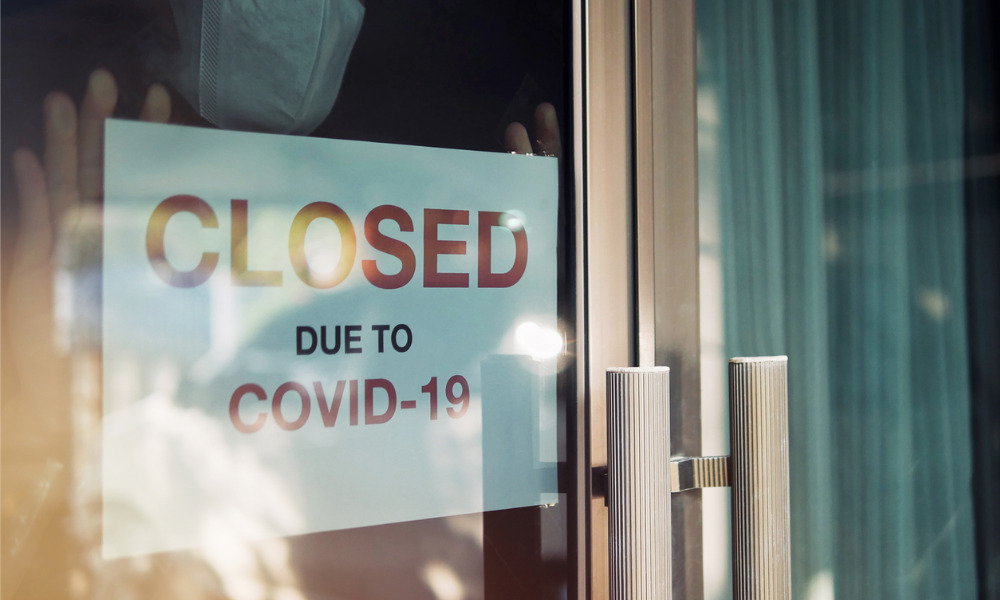
The COVID-19 pandemic continues to impact businesses across the country

Sponsored content
It’s no secret the COVID-19 pandemic wreaked havoc on the Canadian economy in 2020, but while Statistics Canada reported a record-setting 5.4% drop in Canadian real GDP, Annual Insolvency Statistics released by the Office of the Superintendent of Bankruptcy (Canada) showed a marked decline in bankruptcy and proposal filings — a 29.5% decrease year-over-year for individuals and businesses, and an 18.3% decrease for corporate.
There are a number of possible explanations for this apparent disconnect between the financial destructiveness of the pandemic and the lack of bankruptcies and proposal filings, says Stephanie Wanke, senior lawyer editor, insolvency & restructuring, at Practical Law Canada, including the financial support measures from federal and provincial governments, the fact that no limitation periods or timelines were suspended under the Bankruptcy and Insolvency Act, making proposals challenging; the formal statistics don't capture businesses simply closing their doors; and lenders holding off on exercising their remedies.
But Wanke notes bankruptcies and proposals are only two types of formal insolvency proceedings and the decline in those numbers “has been somewhat misleading in terms of showing the actual insolvency activity.”
Receiverships, a remedy primarily used by secured creditors to liquidate businesses in default, and proceedings under the Companies' Creditors Arrangement Act (CCAA), a restructuring statute available to insolvency companies with a minimum of $5M in liabilities, both increased in 2020, by 13.5% for court-appointed receiverships and 58% for the latter.
“Dollar-value wise receiverships and CCAA proceedings are significantly more important,” Wanke says.
Two recent decisions are examples of an ongoing trend where people prefer restructuring under the CCAA over proceedings under the Bankruptcy and Insolvency Act for large or complex insolvency proceedings. In EncoreFX Inc. (Re), 2021 BCSC 750, the first reported decision of a bankrupt company commencing proceedings under the CCAA, the bankruptcy trustee brought the application after a year of complex bankruptcy proceedings, noting that among other benefits the CCAA could be used to impose a settlement on all creditors, if the settlement was accepted by a requisite double majority.
Victor Cantore v. Nemaska Lithium Inc., 2021 CarswellQue 4589 (SCC), saw the Supreme Court refuse leave to appeal of a contested reverse vesting order issued in the underlying CCAA proceedings. This decision is a victory for the reverse vesting order structure, which allows a company in CCAA proceedings to vest unwanted liabilities and assets in another entity so that the debtor company can be sold by way of share sale or otherwise restructured.
“We saw more CCAAs in COVID because many large companies had no way to handle the dramatic industry fluctuations in a temporary way and they needed the benefit of the stay provisions — but also because the CCAA is more suited to restructurings that require creativity,” Wanke says. “The CCAA is a more flexible statute which works well when you need to be practical and innovative.”
The Nemaska decision is a good indication of that approach, she adds, as the “court used inherent jurisdiction to sanction a creative approach by counsel and the SCC declined to intervene.”
Despite the dive of bankruptcy and proposal filings in 2020, Wanke predicts that won’t last as deferred insolvency activity builds. That pent-up defaults in the system will ultimately have to be resolved, especially as some of the contributing factors come to an end.
“There’s a significant risk of a real uptick in all types of insolvency filings once these federal supports wind down,” Wanke notes. " It’s likely we’re going to see more activity later this year and into next year.”
When Practical Law Canada sees industry trends, they respond with tailored resources and the new Insolvency & Restructuring Module offers a robust section that deals with default and enforcement, including forbearance agreements, which are key right now, Wanke says, adding another active area is look-sees, where lenders go in to monitor things while they’re waiting and seeing. COVID-19: Advising a Business in Financial Difficulty is a helpful resource that covers relevant insolvency information, and Practical Law Canada was among the first to develop and launch Canadian and Global COVID-19 toolkits.
With the impact of the pandemic continuing to be felt by people and businesses alike, Wanke and her team continue to develop relevant and timely resources, including currently working with the finance team to create a series of documents on priority disputes.
“As the current economic difficulties turn into insolvency proceedings there will be many disputes in terms of who has priority to different assets,” Wanke says. “These documents will be tailored to help practitioners resolve priority disputes in a practical and efficient manner.”